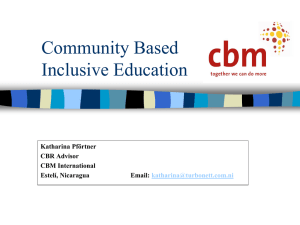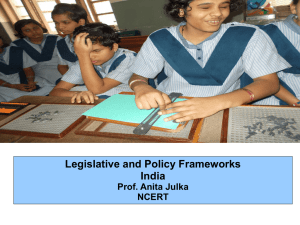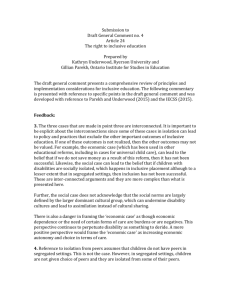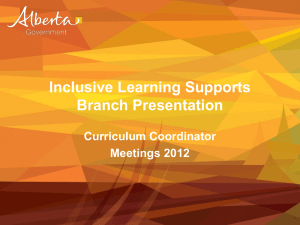Inclusive Education - Australian Disability and Development
advertisement
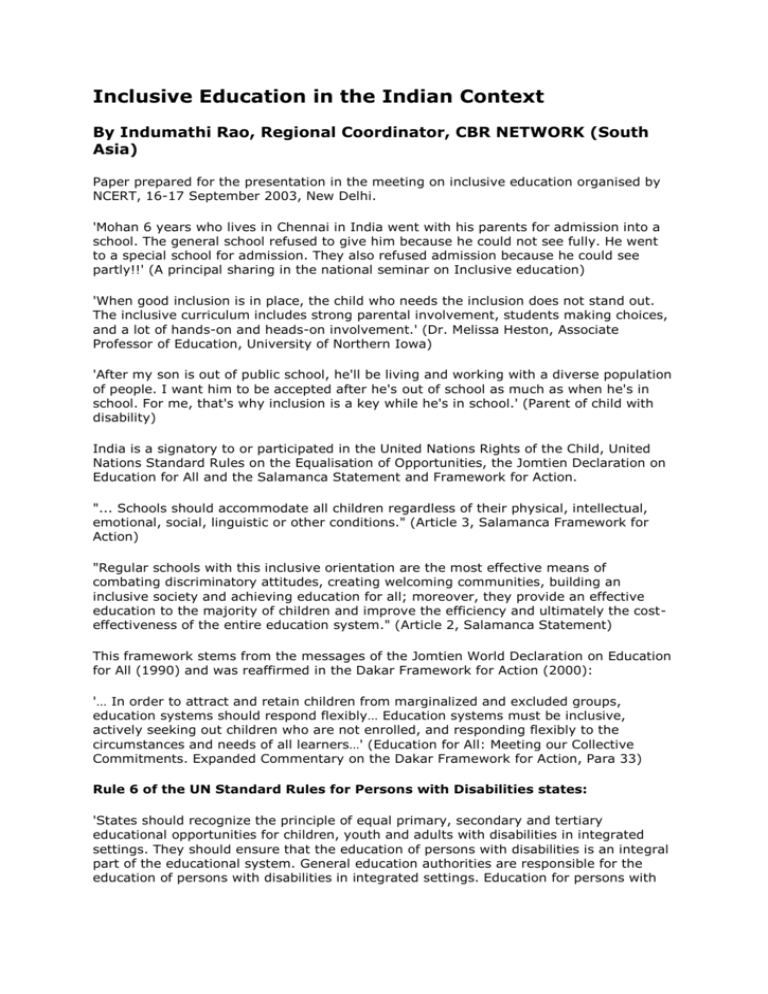
Inclusive Education in the Indian Context By Indumathi Rao, Regional Coordinator, CBR NETWORK (South Asia) Paper prepared for the presentation in the meeting on inclusive education organised by NCERT, 16-17 September 2003, New Delhi. 'Mohan 6 years who lives in Chennai in India went with his parents for admission into a school. The general school refused to give him because he could not see fully. He went to a special school for admission. They also refused admission because he could see partly!!' (A principal sharing in the national seminar on Inclusive education) 'When good inclusion is in place, the child who needs the inclusion does not stand out. The inclusive curriculum includes strong parental involvement, students making choices, and a lot of hands-on and heads-on involvement.' (Dr. Melissa Heston, Associate Professor of Education, University of Northern Iowa) 'After my son is out of public school, he'll be living and working with a diverse population of people. I want him to be accepted after he's out of school as much as when he's in school. For me, that's why inclusion is a key while he's in school.' (Parent of child with disability) India is a signatory to or participated in the United Nations Rights of the Child, United Nations Standard Rules on the Equalisation of Opportunities, the Jomtien Declaration on Education for All and the Salamanca Statement and Framework for Action. "... Schools should accommodate all children regardless of their physical, intellectual, emotional, social, linguistic or other conditions." (Article 3, Salamanca Framework for Action) "Regular schools with this inclusive orientation are the most effective means of combating discriminatory attitudes, creating welcoming communities, building an inclusive society and achieving education for all; moreover, they provide an effective education to the majority of children and improve the efficiency and ultimately the costeffectiveness of the entire education system." (Article 2, Salamanca Statement) This framework stems from the messages of the Jomtien World Declaration on Education for All (1990) and was reaffirmed in the Dakar Framework for Action (2000): '… In order to attract and retain children from marginalized and excluded groups, education systems should respond flexibly… Education systems must be inclusive, actively seeking out children who are not enrolled, and responding flexibly to the circumstances and needs of all learners…' (Education for All: Meeting our Collective Commitments. Expanded Commentary on the Dakar Framework for Action, Para 33) Rule 6 of the UN Standard Rules for Persons with Disabilities states: 'States should recognize the principle of equal primary, secondary and tertiary educational opportunities for children, youth and adults with disabilities in integrated settings. They should ensure that the education of persons with disabilities is an integral part of the educational system. General education authorities are responsible for the education of persons with disabilities in integrated settings. Education for persons with disabilities should form an integral part of national educational planning, curriculum development and school organization.' The Indian 'Equal Opportunities and Rights of Persons with Disabilities ACT' 1995, rule 26, speak about the' education of children with disabilities up to the age of 18 years in an appropriate environment' Why inclusive is different from integrated education? Indian Scenario Education of children with disabilities in India, as all over the world, has moved from segregation, special schools to integrated education. There is a national level central government sponsored scheme called Integrated Education of Disabled Children (IEDC). This project was started in 1980s and designed based on the experience gathered from a UNICEF assisted pilot project called PIED (project on integrated education of disabled children). In the mid-1980s many NGOs implemented this IEDC with grants from government. of India. This project is implemented by the Ministry of Human Resource Development. This is basically an itinerant resource teaching approach and one resource teacher was given to every 8 children with special needs. There are around 60,000 children with disabilities getting access to education under this scheme. By and large the project is managed by the NGO sector. Although the goals and objectives of the IEDC program were laudable, the number of children with disabilities enrolled was woefully small. For example in Karnataka state about 2% of all children with disabilities acquire education. About 1% of these children are enrolled in special schools and the balance 1% are in the integrated education system. Total Special Education Integrated Education Number of children with disabilities who need education: Number of children receiving education in special schools/ institutions Number of children receiving education in integrated schools Location: Karnataka (Number of Special Schools: 120) (Number of Integrated Schools: 2384) Age: 0-14 Yrs Source: Karnataka Door to door survey report-1991 137044 10,000 7.30% Total Grants received Rs. 4 crores (approx) 9462 6.90% Total Grants received Rs 1,15,00,000 (1 crore: Karnataka Govt.3 crores: Govt. of India) Cost per child Rs 4000 Rs 1215 Why we need to move from IEDC? 1. IEDC was heavily dependent on resource teachers in the projects implemented by NGOs. 2. IEDC implemented by Government teachers had a questionable quality because the teachers were trained only for 42 days. 3. In the NGO implemented IED model the quality and support to children in rural areas was inadequate because the resource teachers had to travel from one village to the other, often covering long distances on foot. The time actually available for resource teaching was inadequate. 4. The resource teaching approach in NGO models was also questionable because children were either pulled out from regular classes for resource teaching or they were asked to come before school and stay back after school. This was not a child friendly approach, more so for children in the 4th standard and above, who travelled a long distance, often from neighboring villages, to reach the school. Inclusive Education As a system, inclusive education should be flexible. Its principle should be education in the regular classroom whenever possible. This need for flexibility must be reflected in the methods and materials used to give these children the widest possible access to the regular curriculum. When discussing the kind of service needed, the starting point should always be what is best for the particular child. Emphasising inclusive education does not rule out special schools or centres. They would still be required to cater to children with profound and complex difficulties in need of more specialised and extensive help, including e.g. many deaf children. This alternative should, however, not be considered, unless classroom placement cannot meet their needs. In line with the new policy of inclusive education, special schools begin to function more and more as resource centres. They involve in outreach programmes, where they draw on their vast experience and knowledge. They link their activities with those of the regular schools, the families, and the communities. Inclusive education services allow children with disabilities to stay with their family and to go to the nearest school, just like all other children. This circumstance is of vital importance to their personal development. Interrupting a disabled child's normal development may have far more severe consequences than the disability itself. In this context, it is important to stress the role parents have. They have a right to be involved in all decision-making concerning their child. They should be seen as partners in the education process. Where there is such co-operation, parents have been found to be very important resources for the teachers and the schools. As a rule, there are a number of practical problems that have to be solved before a child with special educational needs can go to school or take part in school activities. The arrangements it takes are fairly simple, provided co-ordinated local and unconventional initiatives are stimulated. One should also remember that the child's schoolmates represent a valuable potential partner who is ready and able to help in overcoming some of these problems. School reform needed which facilitating learning of every child Traditional Approach Inclusive Approach Education for some Education for all Static Flexible Collective teaching Individualised Teaching Learning in segregated areas Learning in Integrated areas Emphasis on teaching subject-orientated Emphasis on learning child-centred Diagnostic / prescriptive Holistic Opportunities limited by Equalisation of opportunities for all exclusion Disability view Curricular view Labels children disability wise Planning is made on ability levels and opposes all kinds of labelling Table 1. Different educational practices (3) Inclusion a holistic vision Any child may experience a special need during the course of educational years (UNESCO). Some children feel 'left-outs' and never enter school or enter only for a few years and, as repeaters, become 'drop-outs' or, more correctly 'pushed-outs', without their needs having been met. These children are a vivid illustration of the failure of schools to teach rather than the pupils' failure to learn. A school system emphasising Education for All should ensure the right of all children to a meaningful education based on individual needs and abilities. (Ture Johnson 2002) The regular schools will now increasingly play a major role in making provision for children with special educational needs available nation-wide. Making the school system flexible and adopting an inclusive approach may, however, prove the most challenging task of all, a task calling for deep reflection and discussion of the two fundamental questions: "What is the overall role of education", and "What is it we want children to learn in school?" It might lead to the need of reforming the school system as a whole from a traditional, examination-oriented to an inclusive, child-oriented approach. Policy and Reality To open up the regular school system to disabled children is not an easy task. The policy on inclusion and mainstreaming can easily become "main dumping" if not implemented carefully. It was, however, pointed out that a big gap exists between this ideal situation and the present reality. There is an urgent need for interventions for equipping general teachers with special skills, making general curricula, teaching methods. Evaluation procedures, learning material disability-sensitive and addressing the attitudes /needs of other children in the school to ensure such interventions benefits all children. It is important to have a holistic, comprehensive and inter-sect oral approach where all pieces are put together. It is not enough to present and implement one part only. An inclusion policy cannot stand-alone and "cannot be a substitute for careful planning of interventions and systematic capacity-building for the implementers of these interventions". (5) The curriculum for "ALL" needs to be: 1. Child centred: Children with disabilities need childcentred curriculum, which takes into account the individual needs of children. The curriculum needs to set specific, observable, measurable and achievable learning outcomes (SOMA). 2. Flexible: A flexible, locally relevant curriculum, teaching and learning strategies are intrinsically important for children with special needs to participate in the educational process. 3. Participatory: Children with special needs require a learning environment in which they can actively participate in learning in small groups learning settings 4. Partnership with parents: Partnership with parents is a key factor as children learn not only in the classrooms but also at home. Conclusion Inclusive education must respond to all pupils as individuals, recognizing individuality as something to be appreciated and respected. Inclusive education responding to special needs will thus have positive returns for all pupils.― All children and young people of the world, with their individual strengths and weaknesses, with their hopes and expectations, have the right to education. It is not our education systems that have a right to a certain type of children. Therefore, it is the school system of a country that must be adjusted to meet the needs of all its children." (6). That is a big and difficult task, but "where there is a will there is a way!" References 1. Helander, E. (1993) Prejudice and Dignity. UNDP, N.Y. 2. The Salamanca Statement and Framework for Action on Special Needs Education. World Conference on Special Needs Education: Access and Quality, Salamanca, Spain, 7-10 June 1994. UNESCO and Ministry of Education and Science, Spain 1994. 3. Jönsson, T. (1995) Inclusive Education. UNDP, Geneva 4. WCEFA. (1990) World Declaration on Education for All, Inter-Agency Commission for the World Conference on Education for All, 1990 5. Gloria Burrett, Mita Nundy. (1994) Convention on the Rights of the Child, The Disabled Child 6. Lindqvist, B. (1994) Special Needs Education: Conceptual Framework, Planning and Policy Factors. Paper presented at the World Conference on Special Needs Education, Salamanca, Spain (From: NU News on Health Care in Developing Countries 2/95, vol.9) 7. Ture Johnsson, (2003) Inclusive education CD developed for CBR Network's distance education programme 8. Rao Indumati, From Panchayat parliament, (2000), CBR NETWORK 9. Rao Indumathi, (2002) Country status on inclusive education/special needs documentation good practices, UNICEF, Regional Office 10. Rao Indumathi, (2001),Understanding inclusive education from heart, EENET newsletters and web publication 11. Mani MNG (2000) Inclusive education, Ramakrishna Vidyalaya, Coimbatore Reference: Title: Inclusive Education in the Indian Context Author: Rao, I Date: 2003 Link: http://www.eenet.org.uk/resources/docs/inclusive_education_indian.php



